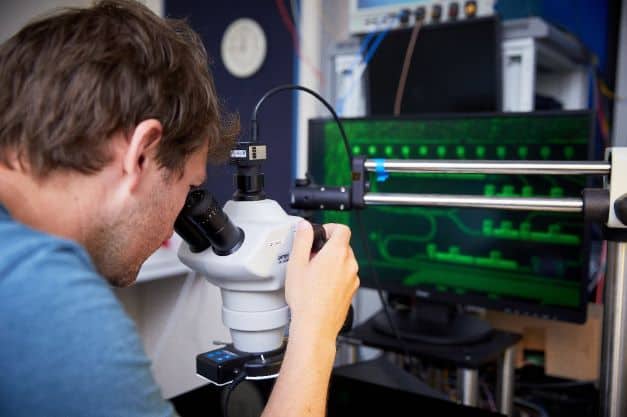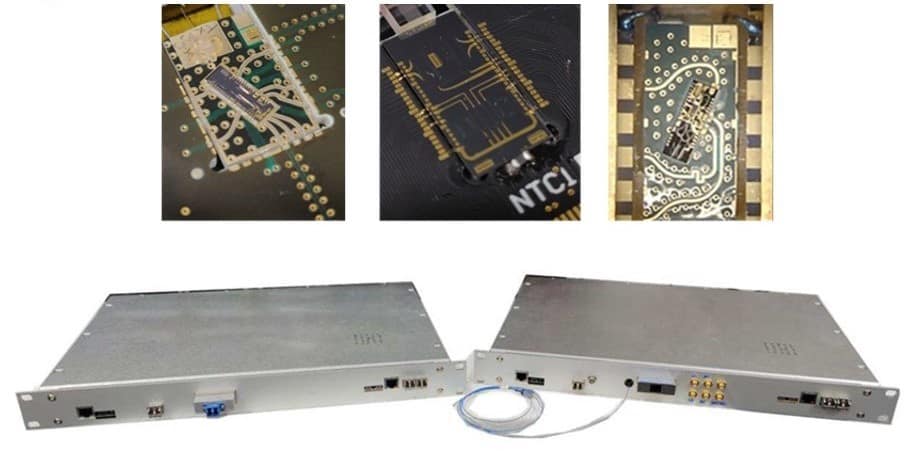
A future in which quantum computers are commonplace might seem like an optimistic fantasy, but it could also involve hackers using those computers to steal important information. To thwart would-be bad actors, researchers developed a cryptographic protocol known as quantum key distribution (QKD) that uses the laws of quantum mechanics to enhance communication security. A team from Toshiba Europe Ltd has now combined a set of chips into compact modules order to build an entire standalone QKD system for the first time, miniaturizing and integrating key components and showing that the resulting system can transmit information autonomously, stably and securely for days, and over tens of kilometres.
One of the miniaturized components in the Toshiba team’s system is a credit-card-sized pluggable module containing a 2 mm x 6 mm transmitter chip that encodes quantum information into light. To do this, a laser produces a very faint pulse that contains, on average, one photon. Information is then “written” into this photon’s precisely tuned quantum mechanical properties in a way that can be decoded by a receiver chip. Importantly, scientists designed the quantum decoding process to be sensitive to any potential eavesdroppers. In other words, had someone intercepted the communication between the two chips, the system would have recognized that “attack” every time.
The new system also includes two photon-based quantum random number generators (QRNGs). These devices govern how the transmitter chip prepares the photonic quantum bits, or qubits, that encode information, and the way the receiver decodes that information. By producing numbers that are so random that they are essentially impossible to guess, QRNGs provide another valuable contribution to the security of the new QKD system, explains Taofiq Paraiso, a research scientist at Toshiba and the first author of a new paper in Nature Photonics that describes the company’s system.
All-in-one package
According to Paraiso’s colleague Thomas Roger, previous demonstrations of QKD systems often did not perform quantum random number generation in real time, or at the same time as they transmitted information. The Toshiba system, in contrast, combines multiple processes, including QRNG, into an all-in-one package that is smaller and more cost-effective than many of its predecessors. “This is the first time that the three chips – quantum transmitter, quantum receiver and QRNG – work together to distil a key from a QKD system,” agrees Marco Lucamarini, a physicist at the University of York, UK, who was not involved with the experiment. Lucamarini also notes that the experimenters removed all the usual supporting lab equipment to test their system, leaving only the chips themselves and the fast electronics that connect them.

While photonic chips have been used in quantum information applications before, Paraiso says it was not previously clear that full system integration was possible. “We put a whole lot of effort into integrating all chips into one system and developing the electronics interface so that all the chips can talk to each other,” he says, adding that the team designed its chips and electronics to be as simple as possible while minimizing the overall power consumption and bulkiness of the setup. Additionally, the designers placed all chips involved in security-critical quantum processes inside pluggable modules already used in conventional optical communications systems.
The importance of integration
The future of quantum communication networks will hinge on the practicality of such integration efforts, says Paolo Villoresi, director of the Padua Quantum Technologies Research Center at the University of Padua, Italy. He explains that researchers like himself and members of the Toshiba team are working to move quantum information systems out of the “unwieldy collections of discrete components” stage of their development by using photonic integration technology that has been shown to work well for standard optical communication networks. “Integrated photonics is sort of following the steps of integrated electronics,” he says. He takes the comparison further: “Nowadays no one is considering going back to bulk transistors.”
Lucamarini agrees, identifying integration as one that is most important issues for practical and commercial uses of QKD. “Scaling bulky QKD systems down to the size of a coin and integrating them in pluggable modules reduces size, energy consumption and cost, therefore bringing this technology much closer to the market,” he says, adding that integrated photonic chips could be mass produced via methods that are already standard in the semiconductor industry.

Multi-party quantum key distribution paves the way for quantum-secure conference calls
Although the Toshiba system is still a prototype, members of the team are enthusiastic about the progress their interdisciplinary group of scientists – who specialize in areas ranging from optics to QRNG – has made. The new experiment showed that the system not only works alongside commercially available encryption systems, but can also operate for weeks or even months at a time without significant errors. In future, they hope to make it yet more compact and, eventually, integrate it into existing conventional communications networks. “There are some subtleties about classical communications networks so you can’t just put in a QKD system and expect it to work across the whole network,” Roger says. “We need to add infrastructure, but that’s something that’s happening.” Villoresi concurs: “Integrated quantum photonics is a field that is currently very alive and vivid.” The new experiment, he says, is an example of how a complete, integrated photon based QKD systems can work in the world outside the lab.
- This article was amended on 3 November 2021 to clarify the size of the chip and module.



